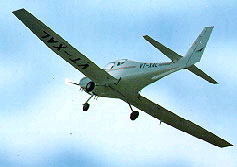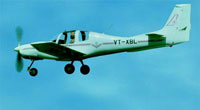Hansa-3, NAL's two-seater trainer, heads for Australia
14 Feb 2007
Bangalore: The National Aerospace Laboratories (NAL), a Bangalore-based constituent of the Council of Scientific and Industrial Research organisation, will exhibit its two-seater, Hansa-3 trainer aircraft at next month's Avalon Air Show in Melbourne, Australia.
 According to NAL officials, a Hansa-3 will be ferried to Australia where it will be reassembled and the virtues of its tiny all-composite frame will be displayed to the Australian public and flying training clubs. NAL officials claim that the aircraft, at Rs60 lakh, will be approximately 20 times cheaper than its nearest competitors, such as the Cessna 152 and the Cessna 172.
According to NAL officials, a Hansa-3 will be ferried to Australia where it will be reassembled and the virtues of its tiny all-composite frame will be displayed to the Australian public and flying training clubs. NAL officials claim that the aircraft, at Rs60 lakh, will be approximately 20 times cheaper than its nearest competitors, such as the Cessna 152 and the Cessna 172.
The Hansa-3 boasts of several attractive features such as excellent visibility, full dual controls, nice control harmony, a proven and a reliable Rotax 914 F3 engine. Overall, NAL officials point out, the Hansa-3 is a rugged, cost-effective and easy-to-maintain aircraft. Though designed primarily for training, private flying, sport and aerobatics, the Hansa can also be used for surveillance activities, aerial photography and coast guard duty.
 But before any sales should occur, NAL will need to get the Hansa certified in Australia. In this regard, NAL officials point out that the Royal Melbourne Institute of Technology's Sir Lawrence Wackett Centre for Aerospace Design Technology has agreed to help them get the Australian Civil Aviation Safety Authority certification.
But before any sales should occur, NAL will need to get the Hansa certified in Australia. In this regard, NAL officials point out that the Royal Melbourne Institute of Technology's Sir Lawrence Wackett Centre for Aerospace Design Technology has agreed to help them get the Australian Civil Aviation Safety Authority certification.
NAL intends to leave the aircraft in Australia at the Sir Lawrence Wackett Centre for a couple of months, allowing its pilots to fly it, and also apply for certification, officials said.
NAL officials also said that they are looking to transfer technology to a private company, which can then produce the Hansa. So far seven Hansa's have been built by NAL, with the ministry of civil aviation ordering six of them.
| Hansa-3 |
| Power plant |
| Rotax 914 F3 turbo-charged engine |
| 100 BHP at 5500 RPM max. continuous |
| 115 BHP at 5800 RPM |
| Propeller |
| Variable pitch 170 cm (67") Hoffmann propeller |
| Performance (ISA sea level) |
| Stall speed with flaps 20° 48 kias |
| Max. cruise speed 115 ktas |
| Max. rate of climb 650 ft/min |
| Endurance 4 hrs |
| Take-off (over 15 m height) 450 m |
| Landing (over 15 m height) 600 m |
| Geometry |
| Wing span 10.47 m |
| Wing area 12.47 m2 |
| Length 7.658 m |
| Height 2.614 m |
| Cabin width 107 cm |
| Weight |
| Empty weight (night operations 545 kg with lightning protection) |
| All-up weight 750 kg |
| Useful load 205 kg |
| Fuel capacity 85 ltr |
| Instruments / Avionics |
| Day operations airspeed indicator, altimeter, vertical speed indicator, outside air temperature, magnetic compass, slip/skid indicator, NAV/ COMM, intercom, emergency locator transmitter (ELT), voltameter and indicators for RPM, manifold pressure, oil pressure, oil temperature and cylinder head temperature. Night operations additionally: artificial horizon, directional gyro, turn co-ordinator, navigation lights, landing lights, anti-collision lights, panel lights and map lights. Optional GPS Electrical system 14 VDC. |







.webp)














